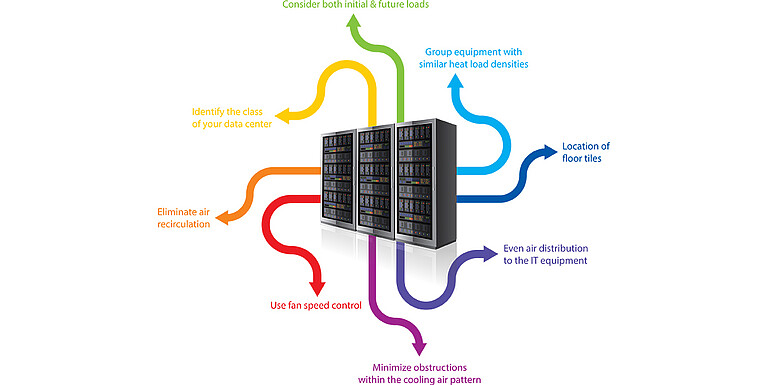Load density, air distribution, floor tile positioning; data center design is more complicated than ever, but with some best practice considerations, creating an efficient, reliable data center design is within your grasp.
Top 10 Data Center Best Practices

Top 10 Data Center Best Practices at a glance

- When designing your data center, consider initial and future loads; in particular part and low-load conditions.
- Lower data center power consumption and increase cooling efficiency by grouping together equipment with similar heat load densities and temperature requirements. This allows cooling systems to be controlled to the least energy-intensive set points for each location.
- As a long-time data center professional, I encourage all my customers to reference the "2011 ASHRAE Thermal Guidelines for Data Processing Environments" to review the standardized operating envelope for the recommended IT operating temperature.
- Identify the class of your data center to determine the recommended and allowable environment envelopes:
- Identify the class of your data center to determine the recommended and allowable environment envelopes:
- "Recommended" combines energy-efficient operation with high reliability.
- "Allowable" outlines boundaries tested by IT equipment manufacturers for functionality.
- Keep in mind that operating outside the recommended envelope may cause server fans to operate at higher speeds and therefore consume more power.
- Higher return air temperatures extend the operating hours of air economizers.
- Higher return air temperature improve cooling infrastructure efficiency, saving both energy and money.
- Implement effective air management to minimize or eliminate mixing air between the cold and hot air sections. This includes configuration of equipment's air intake and heat exhaust paths, location of air supply and air return and the overall airflow patterns of the room. Remember to create barriers and seal openings to eliminate air recirculation. Supply cold air exclusively to cold aisles and pull hot return air only from hot aisles.
- Under-floor and over-head cable management is important to minimize obstructions within the cooling air pattern.
- Using fan speed control to supply only as much air as IT equipment requires can reduce energy use by up to 66%.
- Carefully consider the location of floor tiles to optimize air distribution and prevent short-circuiting.
- Managing a uniform static pressure in the raised floor, by careful placement of the A/C equipment, allows for even air distribution to the IT equipment.
- Create a low pressure drop design to minimize fan power consumption by keeping ducts as large and short as possible, in addition to a generous raised floor.
- Incorporate some form of economizer whenever possible to save money, energy, and the environment.
By utilizing these data center best practices, I believe you are well on your way to a successful design!

